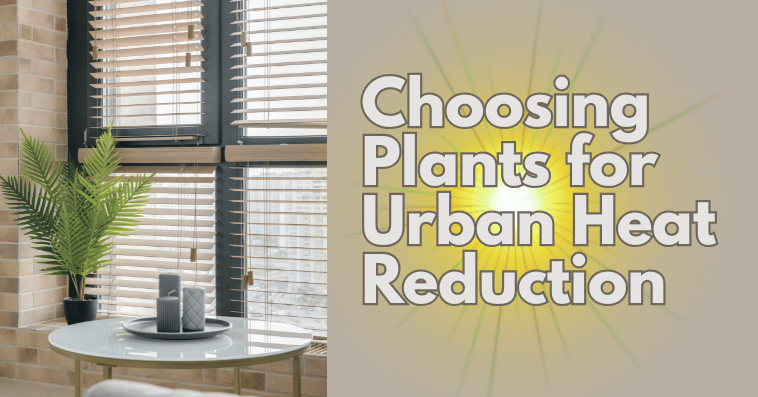Urban areas are known for their scorching heat, especially during the summer. This phenomenon, known as the urban heat island effect, is caused by concrete buildings, asphalt roads, and a lack of greenery. But here’s the good news: nature has a solution. With the right plants, you can reduce urban heat, cool down your surroundings, and create a healthier environment—all while beautifying your space.
Whether you’re a home gardener, apartment dweller, or city planner, this guide will help you choose the best plants for urban heat reduction and explain how to use them effectively for maximum cooling benefits.
Why Does Urban Heat Happen?
In cities, buildings, pavement, and rooftops absorb and trap heat from the sun. Unlike natural landscapes, these surfaces don’t allow heat to escape quickly, causing temperatures to rise significantly higher than in rural areas. This leads to increased energy consumption, air pollution, and even health risks like heatstroke.
Adding the right heat-reducing plants can play a huge role in lowering ambient temperatures, improving air quality, and creating cooler, more livable spaces.
How Do Plants Reduce Heat in Urban Areas?
Plants help combat urban heat in three primary ways:
Shade: Trees and shrubs block direct sunlight, reducing surface temperatures.
Transpiration: Plants release moisture into the air through their leaves, cooling the atmosphere naturally.
Evapotranspiration: Combined with evaporation, this process cools the air similar to how sweating cools the human body.
Best Types of Plants for Urban Heat Reduction
To effectively cool your urban space, choose plants that provide shade, retain moisture, and thrive in high-heat conditions. Here are the top categories and examples:
1. Shade Trees
Shade trees are the most effective option for reducing ground and air temperatures.
✅ Top Choices:
Neem Tree (Azadirachta indica) – Hardy, fast-growing, excellent shade
Peepal Tree (Ficus religiosa) – Sacred tree, large canopy
Gulmohar (Delonix regia) – Wide branches, vibrant blooms
Ashoka Tree (Saraca asoca) – Great for narrow spaces, evergreen
Indian Almond (Terminalia catappa) – Large leaves for maximum shade
Tip: Plant trees on the south or west side of buildings for optimal heat blocking.
2. Ornamental Grasses
Grasses reduce reflected heat from hardscapes like driveways and pathways.
✅ Top Choices:
Fountain Grass (Pennisetum setaceum)
Lemon Grass (Cymbopogon citratus)
Vetiver Grass (Chrysopogon zizanioides) – Known for soil binding and cooling
These grasses require minimal maintenance and thrive even in full sun.
3. Groundcovers and Vines
Groundcovers keep the soil cool, reduce heat radiation, and prevent erosion.
✅ Groundcover Choices:
Money Plant (Pilea or Epipremnum aureum)
Mondo Grass (Ophiopogon japonicus)
Periwinkle (Vinca major) – Attractive flowers and drought-tolerant
✅ Vines for Vertical Cooling:
Bougainvillea – Thrives in sunlight, perfect for walls and trellises
Ivy (Hedera helix) – Covers facades, reducing wall heat
Climbing Roses – Adds both shade and aesthetics
4. Flowering Shrubs and Perennials
These provide partial shade and visual appeal while aiding in evapotranspiration.
✅ Great Options:
Hibiscus (Hibiscus rosa-sinensis)
Lantana (Lantana camara)
Jasmine (Jasminum sambac) – Also fragrant and low maintenance
5. Indoor and Balcony Plants for Urban Dwellers
Even small apartments can contribute to reducing indoor and outdoor temperatures.
✅ Top Picks:
Areca Palm – A natural humidifier
Rubber Plant – Big leaves for better transpiration
Snake Plant – Hardy and air-purifying
Peace Lily – Cools and cleans indoor air
Use vertical planters or railing pots to create a green barrier around balconies.
Design Tips for Maximum Heat Reduction
To make the most of your urban gardening efforts, follow these strategic planting tips:
Create green roofs or terraces using potted shrubs and grasses
Install vertical gardens on building walls
Plant trees along walkways and open spaces
Use climbers on pergolas to create shaded seating zones
Combine trees, shrubs, and groundcovers for a multi-layer cooling effect
Caring for Heat-Reducing Plants
These plants are generally low-maintenance, but you still need to ensure:
Regular watering, especially during dry months
Mulching to retain soil moisture and cool the root zone
Organic fertilizing to keep foliage healthy
Pruning to maintain airflow and desired shape
Compost and organic soil mixes can further enhance their heat-reducing potential.
Urban Heat and Climate Change: Why Your Garden Matters
With global temperatures on the rise, planting greenery in urban settings is not just about aesthetics—it's an act of environmental responsibility. By choosing the right plants, you contribute to:
Reducing energy usage by cooling surrounding areas
Lowering greenhouse gas emissions
Providing habitats for birds and pollinators
Creating green spaces that promote mental well-being
Even one balcony garden or terrace planter can make a difference!
Buy Heat-Reducing Plants from PaudheWale
Looking to cool your home and contribute to a greener city? Explore a wide range of urban-friendly, heat-reducing plants at PaudheWale. From shade-giving trees to potted balcony plants, PaudheWale offers high-quality plants, tools, and expert gardening solutions to transform your urban space into a cool, green oasis.
Don’t just garden — garden with impact.
Shop now from PaudheWale and take the first step toward a cooler, greener future.

